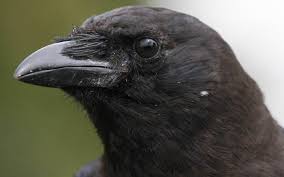Crows are members of a widely distributedgenus of birds, Corvus, in the family Corvidae. Ranging in size from the relatively small pigeon-size jackdaws(Eurasian and Daurian) to the Common Raven of the Holarctic region and Thick-billed Raven of the highlands of Ethiopia, the 40 or so members of this genus occur on all temperate continents except for South America, and several islands. In Europe, the word "crow" is used to refer to the Carrion Crow or the Hooded Crow, while in North America it is used for the American Crow or theNorthwestern Crow.
The crow genus makes up a third of the species in theCorvidae family. Crows appear to have evolved in Asia from the corvid stock, which had evolved in Australia. The collective name for a group of crows is a flock or amurder.
Recent research has found some crow species capable of not only tool use but also tool construction and meta-tool use. Crows are now considered to be among the world's most intelligent animals with anencephalization quotient approaching that of some apes.The Jackdaw and the European Magpie have been found to have a nidopalliumapproximately the same relative size as the functionally equivalent neocortex in chimpanzees and humans, and significantly larger than is found in the gibbon.
Description
Corvus species are all black or black with little white or grey plumage. They are stout with strong bills and legs. The sexes are not very different in appearance.

Behaviour
Crows make a wide variety of calls or vocalizations. Crows have also been observed to respond to calls of other species; this behavior is, it is presumed, learned because it varies regionally. Crows' vocalizations are complex and poorly understood. Some of the many vocalizations that crows make are a "Koww", usually echoed back and forth between birds; a series of "Kowws" in discrete units; a long caw followed by a series of short caws (usually made when a bird takes off from a perch); an echo-like "eh-aw" sound; and more. These vocalizations vary by species, and within each species they vary regionally. In many species, the pattern and number of the numerical vocalizations have been observed to change in response to events in the surroundings (e.g. arrival or departure of crows).

No comments:
Post a Comment